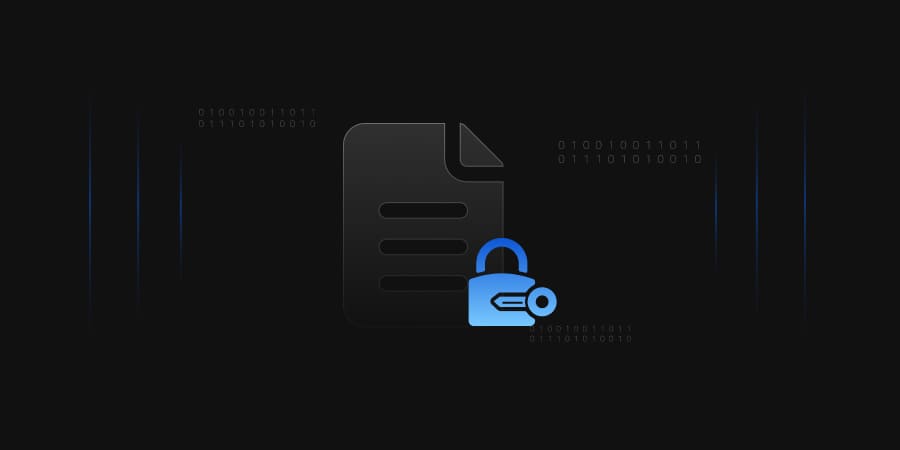A sender encrypts data using a password, which the recipient must know to access. It is called symmetric, as the same key is used for encryption and decryption. Symmetric cryptography uses a single shared secret to share the encrypted data between different parties, which is why it’s also known as Secret Key Cryptography.
Mechanism of Symmetric Encryption
Symmetric Encryption is a two-way process where a block of plaintext with a given key, called symmetric ciphers, will produce the same original ciphertext. Similarly, if the same key is used on that ciphertext block, it will always produce the original plaintext.
This method is useful when protecting data between parties with an established shared key and for frequently storing confidential data.
For example, ASP.NET uses the 3DES technique to encrypt all the cookie data for a form’s authentication ticket.
Uses of Symmetric Encryption
Symmetric Encryption is an older Encryption method, but it is more efficient and faster than Asymmetric Encryption.
Asymmetric Encryption takes a toll on networks due to heavy CPU use and performance issues with data size. For bulk Encryption or encrypting large amounts of data, Symmetric Encryption is used.
For example, Database encryption. When a database is considered, the secret key can only be available to the dataset for encrypting and decrypting.
A few applications of symmetric cryptography are:
- Hashing or Random number generation method.
- Payment applications like card transactions where the PII is needed to be protected to prevent identity theft or fraudulent charges.
- Validations for confirming whether a message’s senders are who they claim to be.
Major Challenges of Symmetric Cryptography
The weakest point of symmetric Encryption is its aspects of key management.
-
Key exhaustion
In this type of Encryption, every use of a cipher or key leaks some information that an attacker can potentially use for reconstructing the key. To overcome this, the best way is to use a key hierarchy to ensure that master or key-encryption keys are never over-used and appropriate rotation of keys is done.
-
Attribution data
Symmetric keys do not have embedded metadata for recording information which generally consists of an expiry date or an Access Control List for indicating the use of the key may be put to. This can be addressed by standards like ANSI X9-31, where a key is bound to information prescribing its usage.
-
Key Management at large scale
If the number of keys ranges from tens to low hundreds, the management overhead is modest and may be handled by human activity or manually. But, with a large estate, tracking keys’ expiration and rotation arrangement become impractical. So, special software is recommended to maintain the proper life cycle for each created key.
-
Trust Problem
It is very important to verify the source’s identity and the integrity of the received data. Suppose the data is related to a financial transaction or a contract, the stakes are higher then. Although a symmetric key can be used for verifying the sender’s identity who originated a set of data, this authentication scheme can encounter some problems related to trust.
-
Key Exchange Problem
This problem arises from the fact that communicating parties need to share a secret key before establishing a secure communication and then need to ensure that the secret key remains secure. A direct key exchange may prove to be harmful in this scenario and may not be feasible due to risk and inconvenience.
How does Symmetric Cryptography get used today?
Both symmetric and asymmetric cryptography is still used often today, even in conjunction with one another. But in terms of Speed, symmetric cryptography beats out asymmetric cryptography.
In symmetric cryptography, the keys used are much shorter or smaller than that in asymmetric cryptography; also, the fact that only one key gets used makes the entire process faster (in asymmetric, two keys are used). Symmetric Cryptography is used when speed is of priority over the increased amount of security.
In Data Storage, symmetric encryption is used to encrypt data stored on a device. But this data is not being transferred anywhere. Also, for Banking, symmetric Encryption is used for encrypting card information or other personal details required for a necessary transaction.
There are many use cases where a combination of both symmetric and asymmetric cryptography is required to improve speed and security. The most common use cases for this hybrid approach are:
-
Mobile Chat Systems
Asymmetric cryptography is used to verify users’ identity at the start of any conversation. After this, symmetric cryptography is used to encrypt the ongoing part of the conversation.
-
SSL/TLS
Asymmetric cryptography is used for encrypting a single-use symmetric encryption key. This gets used for encrypting or decrypting the contents of that internet browsing session.
Conclusion
Symmetric Cryptography has proved to be the better choice when banking-grade security is considered for outbalancing all the disadvantages of asymmetric cryptography. Professional banking-grade key management systems will help compensate for the disadvantages of asymmetric cryptography and turn those into advantages.




